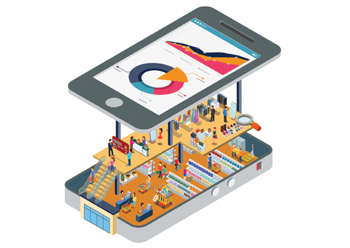
 Radio frequency identification (RFID) helps retailers easily manage inventory in real time
Radio frequency identification (RFID) helps retailers easily manage inventory in real time
There’s a perfect storm aligning for retail success in the UAE. All the economic indicators are pointing in the right direction: duty free spending passed the $1 billion mark in the first half of 2022 matched by a scramble to hire more associates. And shoppers are returning to shop in stores, seeking speed, convenience, and a seamless experience.
The UAE is also the e-commerce leader among Gulf Cooperation Council (GCC) states with estimates indicating the market jumped a stunning 53 per cent in 2020 with a record $3.9 billion in eCommerce sales, constituting 10 per cent of total retail sales (largely driven by a digital shift which arose during the pandemic). Total e-commerce reached just over $5 billion in 2021 and is projected to cross $8 billion by 2025 from online to brick-and-mortar sales.
.jpg) |
|
Hozefa Saylawala |
Let it rain, say UAE retailers. But are they prepared to meet the exponential growth of omnichannel demand? Shoppers are shopping – in-stores, online, mobile and blending them all with buy online, pick-up or return in stores (BOPIS/BORIS), curbside pickup, delivery to other stores or same day home delivery – and their experience matters. In fact, according to the 14th annual Zebra Global Shopper Study, nearly seven-in-10 (69 per cent) shoppers say they prefer a blended shopping experience and prefer online retailers (67 per cent) that also offer brick-and-mortar locations.
Retailers everywhere are trying to balance growing omnichannel customer demand by taking a single view of e-commerce and in-store inventory to ensure they have enough of the right products to fulfil orders from wherever makes most sense. Physical retailers have an advantage over pure plays because they can leverage stores both for brand experience and as distributed fulfilment centres.
It’s clear retailer focus must shift to inventory if they’re going to fulfill this booming multi-channel demand accurately and efficiently. Meaning, they must know that every item is in the right place at the right time. All the time.
ENTER RFID TECHNOLOGY
 |
In the Middle East RFID is gaining more traction as retailers seek to achieve ‘perpetual inventory’ |
Radio frequency identification (RFID) helps retailers easily manage inventory in real time, so it’s always accurate and fully visible. It’s more important than ever as omnichannel retail is only expanding. Workers need to be able to quickly locate the items shoppers want. Online and mobile orders need to be filled quickly and accurately from stores or the warehouse, so items are ready to fulfill whether shipped or when shoppers arrive. And perhaps most importantly, out of stocks and overstocks need to be eliminated to prevent missed sales. Did you know seven-in-10 of shoppers leave stores without all the items they intended to buy, and about half (49 per cent) say it was due to out-of-stocks? And according to a recent IHL global study, the cost of our-of-stocks and overstocks to retailers is a mindboggling $1.993T (+12.7 pp since 2020).
There’s a domino effect between inaccurate inventory and lack of visibility and shopper – and retailer’s experiences: inaccurate, unseen and mismanaged inventory results in unsatisfied customers leaving stores without all the items they wanted and unempowered associates who are unable to answer customer questions or accurately pick/pack online orders. Not to mention the excess time spent on manual inventory tracking that takes associates away from the higher value work they prefer – helping customers.
RFID technology enables digital data to be encoded in RFID tags or smart labels and it “reads” them rapidly, automatically tracking and tracing items as they move throughout a store or warehouse, and out the door to customers. Retailers have depended on RFID for counting stock and now are increasingly turning to it to easily create smart stores with the real-time inventory visibility needed to meet the distinct challenge blended channels bring.
Ideally a retailer can use one RFID platform to connect every system, device, RFID tag and worker to optimise workflows from cross docking and item finding to inventory/cycle counting, replenishment, receiving and omnichannel order fulfillment from the warehouse or store.
RFID also supports the customer as they continue to return to the in-person shopping experience. This is also true in the Middle East, where RFID is gaining more traction as retailers seek to achieve this state of ‘perpetual inventory’. For example, ceiling-based RFID sensors can read what the retailer has in store from the moment it arrives at the back of store, to the point it leaves at the POS.
With the right technology deployment, you can also see what item of clothing (a belt or pair of trousers, for example) has been picked up and tried on – and ultimately what went into the shopping basket. This information can be compared to the POS conversion rate: what item was tried on, what combination of items were tried, and what was actually sold. This data can then be shared with merchandisers and category managers in real time, enabling better analysis of range performance.
It’s like a hidden smart engine that helps retailers ensure good customer experiences, more satisfied associates, and the ability to keep up with e-commerce orders right at the right time – now.
As countries across the Middle East are looking to fully recover from the pandemic and for the likes of UAE, re-assert itself as a global destination for retail and customer experiences, RFID technology will play a key role in the blended retail environment. It gives retailers reliable visibility they can literally count on – to know exactly where their stock is, enabling seamless customer fulfillment, however they shop. Deeper visibility, better business insights, smarter stores and retail decisions ultimately align for better store performance, shopper experiences and retail success on the horizon.












